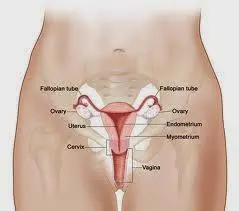Your cervix is the tunnel-like passageway that leads from your vaginal canal to your uterus. It opens first during ovulation to allow sperm into the reproductive tract, and again if pregnancy is not achieved to allow the lining of the uterus to pass during menstruation. The cervix also produces cervical mucus to prevent infection, help balance vaginal pH, and aid in a safe union of sperm with egg. The cervix rocks.
If you do become pregnant, your cervix forms a mucus plug to prevent infection from reaching your baby or babies inside. During the final weeks of your pregnancy, this mucus plug may begin to loosen slowly or fall out all at once as a result of cervical dilation. While the loss of a mucus plug does indicate cervix dilation, it doesn’t necessarily mean labor is imminent. Some women lose their mucous plugs weeks before their labor, others hours before. Increased gooey, snot-like vaginal discharge which may or may not be mixed with blood is a sound, albeit yucky, indication of dilation.
Dilation and effacement, by the way, is the process in which your cervix thins and opens to allow your baby to be born. It’s time to push when your cervix has reached 10 centimeters (cm) dilated and is 100-percent effaced or thinned. Many women begin to dilate before their labor by some time, even weeks. Labor is not considered “begun” until the cervix is dilated to at least 4 cm.
Regardless, your prenatal care provider will likely begin checking your cervix for dilation at about 36 weeks to try to get a slightly less-rough estimate of your delivery date than a due date offers. If you wish to check your cervix yourself, perhaps in between appointments to chart your progress or to avoid going to the hospital too early, this guide on how to check your cervix for dilation should be of help.
You may also want to check your cervical position while trying to conceive to help pinpoint ovulation or your fertile window. For those who stumbled on this page trying to do just that, your cervix rises, softens, and opens during ovulation and is lower, firmer, and closed during infertile times. You can check your cervix for fertility or ovulation by following this guide as well. More information on pinpointing ovulation can be found here.
Locating your cervix:
The first step in checking your cervix for dilation or fertility is to understand where your cervix is.
If you feel to the very back of your vagina (comfortable positions will be covered in the next step), and you are early in pregnancy or not pregnant and have never had a baby before, you will feel a small dimple similar to the tip of your nose. This is your cervix. If you have had a baby before, your cervix may feel closer to a chin or puckered lips and have sort of a donut shape as childbirth forever changes it. Your cervix may also feel this way if you are later in pregnancy and it’s begun to dilate or if you aren’t pregnant and currently fertile.
Also, note that your cervix does move throughout the day, so if you’re checking for ovulation, check at the same time every day. During pregnancy, most women find their cervix is high and posterior or pointing away from the birth canal until later in pregnancy as it moves forward, or anterior, pointing into the birth canal and sometimes becomes lower. Some doulas feel the movement of the cervix from posterior to anterior is an indication of labor soon to come. However, while it is true that as labor begins your cervix will usually be in an anterior position, your cervix can move at any time before labor begins.
Preparing to check your cervix:
First, wash your hands thoroughly to avoid introducing bacteria that could lead to infection. If your nails have any length you may want to wear latex gloves to reduce the chance of scratching yourself internally. Trimmer nails are more ideal. You’ll want a comfortable, warm, and private location where you can either lie down or squat. Some women suggest the shower may be the ideal location as you are already clean and undressed.
If you like, while checking for dilation you can do a visual check as well. Visual checks are tricky to pull off and don’t really offer much, but if it’s something you want to do, you will also need a speculum (usually purchasable from pharmacies or online), a flashlight, and a mirror. Visual checks aren’t a necessity as they are more to check for disease or infection, but if you’re trying to determine if you’re pregnant by checking your cervix, in about 50 percent of pregnant women the cervix is purple or blue in color from increased blood flow.
To perform a visual check follow the instructions here. What is and isn’t normal as far as cervix appearance is also covered. As a visual check doesn’t do anything extra in regards to knowing how dilated your cervix is or if you’re in a fertile window, in-depth instructions won’t be covered in this guide.
How to check your cervix for dilation:
Find a position that’s comfortable for you. If you’re doing a dilation and visual check, choose a location where you can prop yourself up slightly using pillows or bedding and lie on your back. Those doing a simple dilation check will likely find it easier to place one foot on the edge of the bathtub or toilet and squat slightly. You can even find visual instructions for this method on tampon instruction booklets as it opens the vaginal canal and makes it easily accessible. If you are just checking for ovulation, you may be able to check your cervix just sitting on the toilet, but while pregnant, or if you aren’t in a fertile window when not pregnant, you may find your cervix is too high to reach this way.
To perform the cervical check, insert two fingers into your vaginal canal and find your cervix. If you feel an opening in your cervix, this means dilation has occurred. Every finger that can be fit inside is about one cm dilation. For example, if you can fit two fingers inside even stretching a bit, you are around 2 cm dilated. Keep in mind that women who have already had a vaginal delivery almost always have a slight opening. If your cervix is very open and you’re pregnant, you may feel a latex-like sack, this is your bag of waters, which your baby sits within. You might even feel the hard top of your baby’s head within this sack. If you only feel the baby’s head, this means your bag of waters has ruptured, seek medical attention immediately.
It’s best to avoid frequent cervix checks during pregnancy as it may irritate the cervix and, of course, increases the risk of infection, but if you just have to know, we hope this guide has helped.



